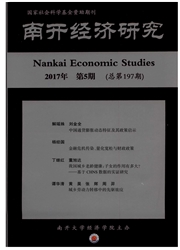

 中文摘要:
中文摘要:
本文基于江苏省2003—2007年企业层面的微观数据,采用“倾向评分匹配”与“倍差法”相结合的估计方法,分别从总体样本、滞后效应、企业所有制、行业技术属性、企业是否出口以及有无研发投入等方面,实证研究了江苏省企业“走出去”的事后“生产率效应”。计量检验结果表明:(1)江苏省企业“走出去”,短期内对生产率提升的促进作用不是很大且不够稳健,但长期内显著提升了企业生产率,而且这种提升作用随着时间的推移不断增大;(2)江苏省国有企业和民营企业开展对外直接投资均产生了显著的生产率提升效应,且国有企业生产率提升幅度更大;(3)低技术密集型企业进行OFDI的生产率提升绩效要优于高技术密集型企业;(4)非出口企业进行OFDI显著提高了企业生产率,而出口企业进行OFDI的“生产率效应”并不显著;(5)有研发投入的企业进行OFDI显著提升了母国企业生产率水平,而没有研发投入的企业“生产率效应”不明显。
 英文摘要:
英文摘要:
Employing the PSM and DID estimation method, this paper examined the pro- ductivity effect of Chinese enterprises' outward foreign direct investment using firm-level industrial data and outward foreign direct investment data from 2003 to 2007 of Jiangsu province. In order to ensure the reliability of the results, we also checked the effect of OFDI on TFP from the perspective of total sample, lag effect, ownership, technological inten- sity, export and R&D respectively. Based on the research, we find that: 1) After OFDI, enterprises can improve productivity at home, but this effect is lagged and become greater as time goes by; 2) Both state-owned enterprises and private enterprises in Jiangsu province could improve productivity after their OFDI activities, but the effect on the state- owned enterprise is more significant; 3) Low technology-intensive enterprises can do bet- ter than high technology-intensive enterprises in productivity growth after initiating OFDI; 4) Export enterprises could hardly improve productivity after their OFDI while non-export enterprises can; 5) The enterprises with R&D investment can do better than those without R&D investment in productivity growth after their OFDI activities.
 同期刊论文项目
同期刊论文项目
 同项目期刊论文
同项目期刊论文
 期刊信息
期刊信息
